Soylent: The Blog Series
For the next month, I will not be eating normal food, but will instead be subsisting almost exclusively off of Soylent. Soylent is a a powder which contains all of the nutrients that a human body needs to be healthy (at least, as far as modern science knows). When mixed with water, it yields a bland, brownish liquid that you drink.
What exactly do we call this concoction? The side of the box it was shipped in bears the tagline "powdered food." Some have referred to it as a "food alternative," or have suggested that they are eating Soylent instead of food. Most importantly, there's no shortage of articles and blog posts discussing the various philosophical aspects of Soylent - is it food? Will people want to eat it? Isn't food meant to be social? I have thoughts on these questions, but that's not the point of this blog series. I may write a post on the subject, but for the most part this series is about my personal experience with Soylent, and the practicalities of using it as a replacement for a traditional diet.
The Blog Series
As I mentioned, this blog series is focused primarily on my experience with Soylent and the practicalities of using it as a replacement for a traditional diet. I'm going to use it as a sort of scientific log book or journal, documenting how the Soylent tastes, how it's making me feel, whether I've stripped the paint off of any of my walls with my farts [1], and so on. I hope to post once a day. I expect that most posts will be fairly brief, and not much will change day-to-day ("Still haven't died; my housemates still hate my intestines."). From time to time I may do a review post noting trends that I've seen over the past x amount of time.
The Why
A reasonable question to ask is why - why am eating Soylent for a month? That's easy - I'm doing it to see how it affects me so that in the future I'll know if it's a viable option (I'm on meal plan at college this year, so I won't be using Soylent long-term for at least another nine months). The harder question is - why would I want to do it long term?
I have two main reasons. First, it's easy. I'm really not a fan of the chores of life - the stuff that you do so you can keep living the parts of life that you look forward to. While I don't consider eating to be a chore, it's a different story for cooking, cleaning, and shopping for food. When my life is relaxed and not too busy, this isn't such a big deal, but when it does get busy, time spent on those chores is time that I invariably don't spend on more enjoyable activities.
Second, it's healthy. I'm something of a garbage truck when it comes to food - I basically just eat whatever tastes good. This is fun while I'm young, but it's clearly going to come back to bite me later in life. And, yes, eating a normal healthy diet is obviously an option, but I know myself, and I know that planning, executing, and, most importantly, paying for a healthy diet isn't something I'm realistically going to do. Soylent is (as far as we know) very healthy, and it's cheap and requires no effort or planning.
Now, there's more to it than just that, but those are my primary reasons - the rest is just minutiae. Hopefully this little primer on my thinking will give context to this blog series and my opinions on and reactions to different aspects of Soylent.
The What
"So you're really eating nothing but Soylent for a month?" Well, no. Not exactly. What I want to do is test the efficacy of living off of it exclusively. But I don't think that occasionally eating normal food is going to mean that my results suddenly are wildly inaccurate. I'm not trying to get precise numerical results - I'm just trying to get a general sense of how an all-Soylent diet affects me. In light of this caveat, I'm going to allow myself a few exceptions:
- An occasional snack or desert (so long as it doesn't constitute a meaningful portion of my daily intake)
- Social eating (going out to dinner with friends and whatnot). I'll try to have Soylent in social situations whenever possible, but I'm obviously not going to bring a water bottle of Soylent to a restaurant.
- Additives to make the Soylent itself taste better (so long as they don't constitute a meaningful portion of my daily intake)
Nonetheless, I'm going to try to stick as closely as possible to the spirit of going "all Soylent." I may adjust how much Soylent I eat (for example, if I'm not getting enough calories each day), but in general, I won't introduce non-Soylent food as a significant part of my diet.
The Unboxing
When you order Soylent, the first thing that you get is not the Soylent itself, but a "starter kit." It includes a pitcher for mixing and storing the Soylent, and a measuring cup which holds one half serving's amount of Soylent powder.
Then comes the real behemoth - the Soylent itself. I ordered a month's supply of Soylent, so it came in a box big enough to uncomfortably smuggle a human. Inside the box were four smaller boxes, each containing a week's supply of Soylent and a small instruction booklet.
The booklet is labeled "Soylent 1.0 Release Notes," a clear nod to Soylent's open source ethos.
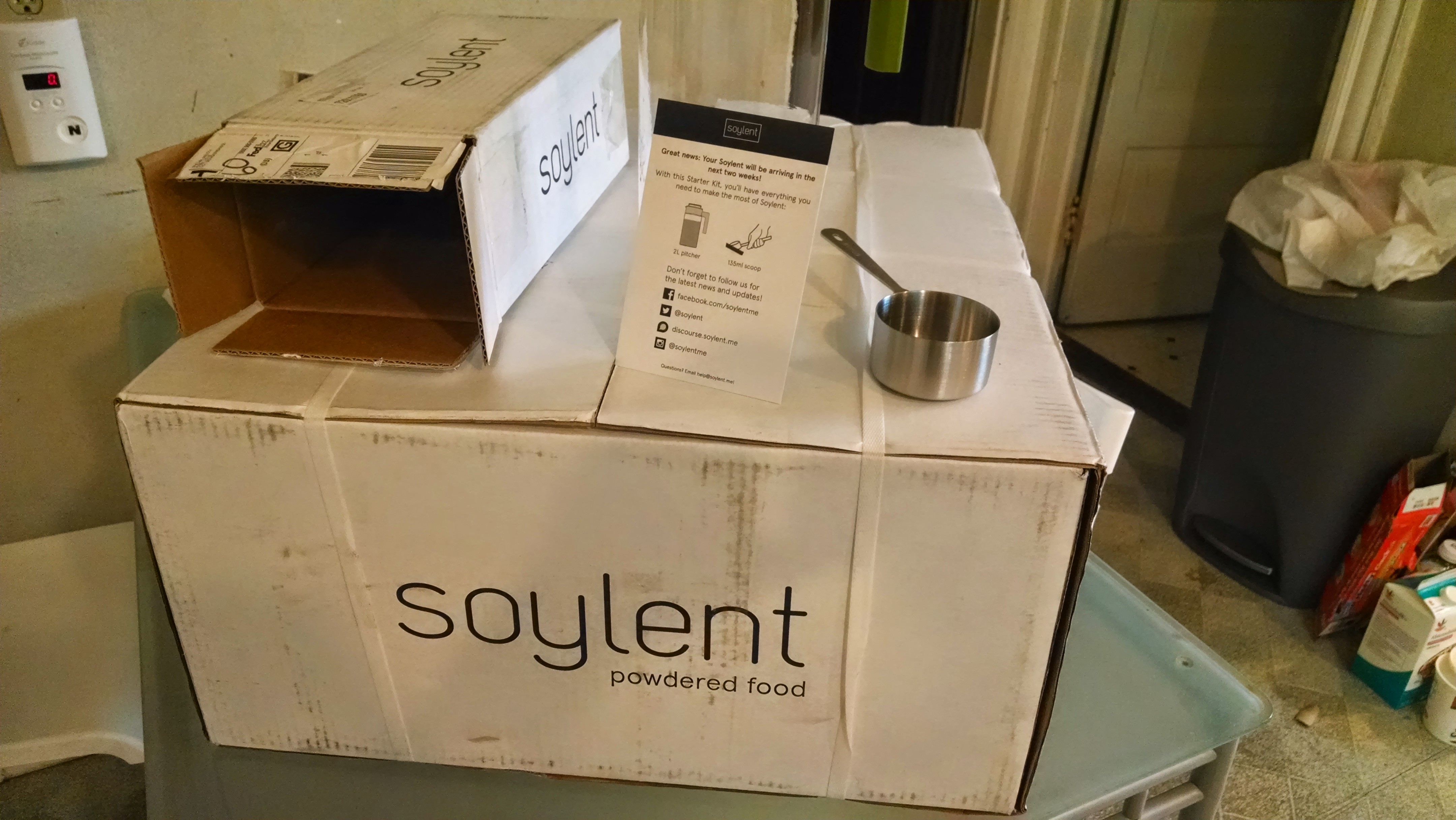
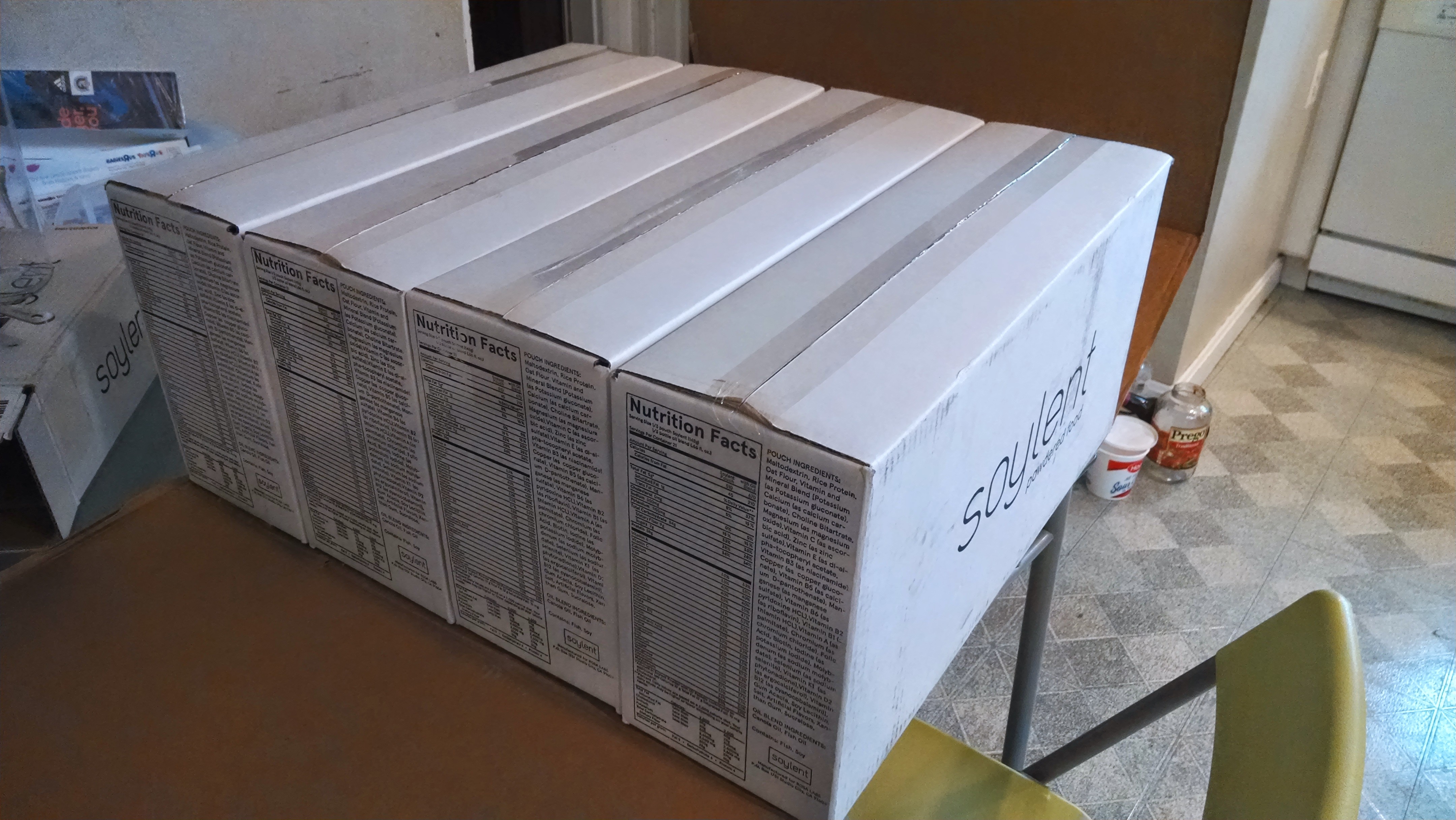
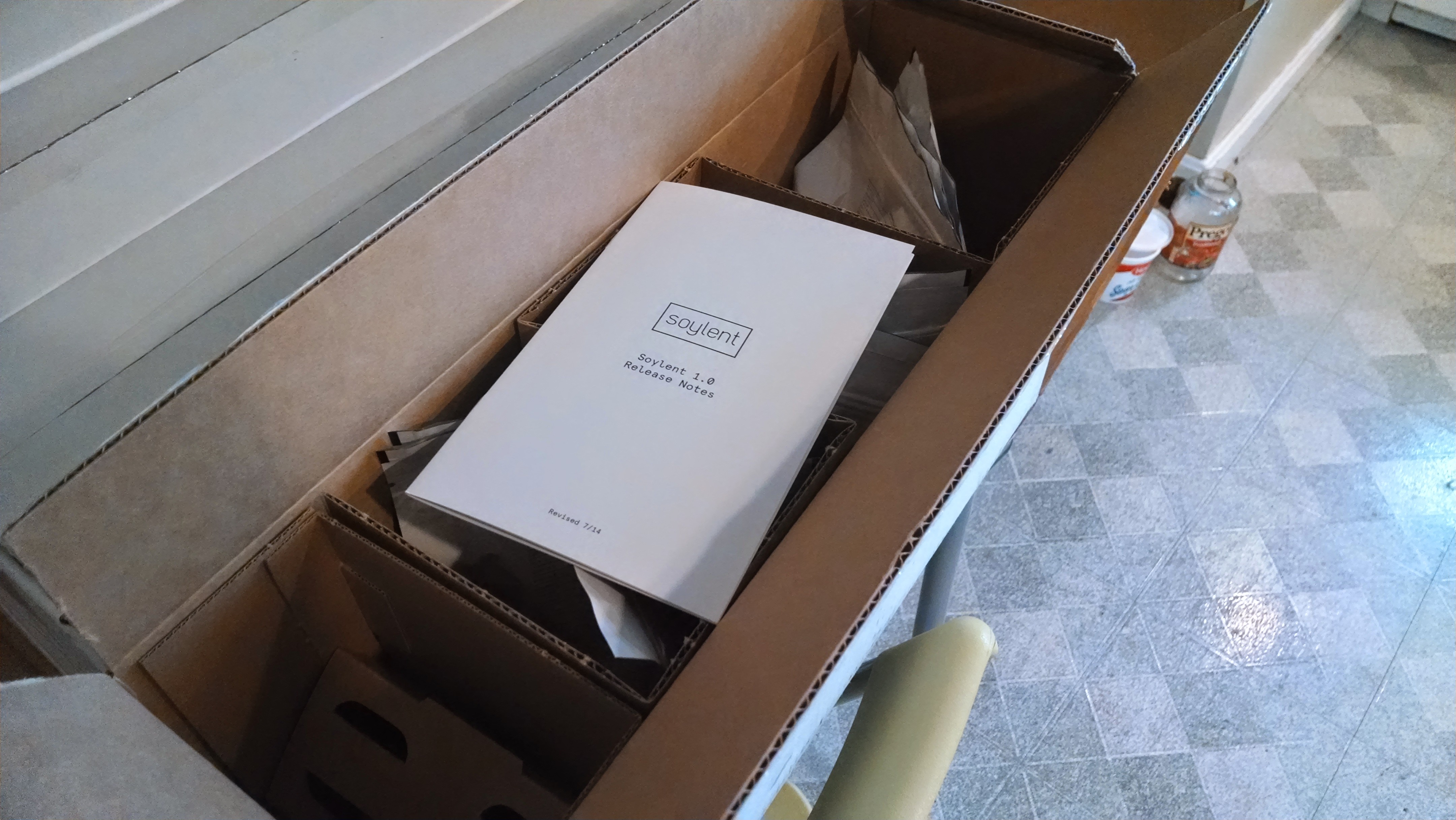
The Soylent itself comes in seven packages - one per day - and seven small bottles of oil blend. A few of the ingredients in Soylent are sourced from animal products, and in an effort to remain vegan-friendly, these are packaged separately in the oil blend. Soylent's makers claim they hope to eventually find vegan alternatives so that they can sell Soylent as the powder alone.
The pouches themselves are, like everything in the box and the box itself, styled minimalistically - plain black text on a white background. They bear only the logo and nutrition facts.
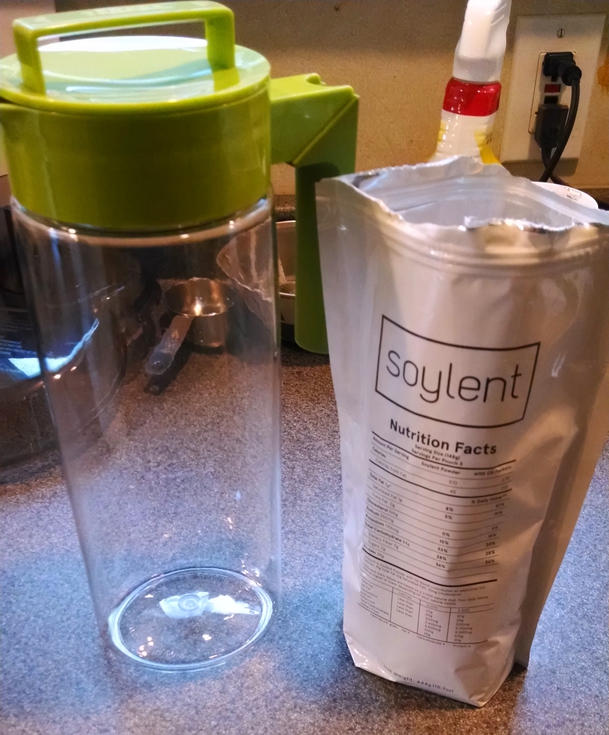
The powder is beige and quite dense. If you drop the pouch on the counter, the powder settles with a single muted thud. It gives off a pungent, sickly sweet smell (I had just eaten five servings of Twizzlers as a last hurrah, so that probably lowered my tolerance).
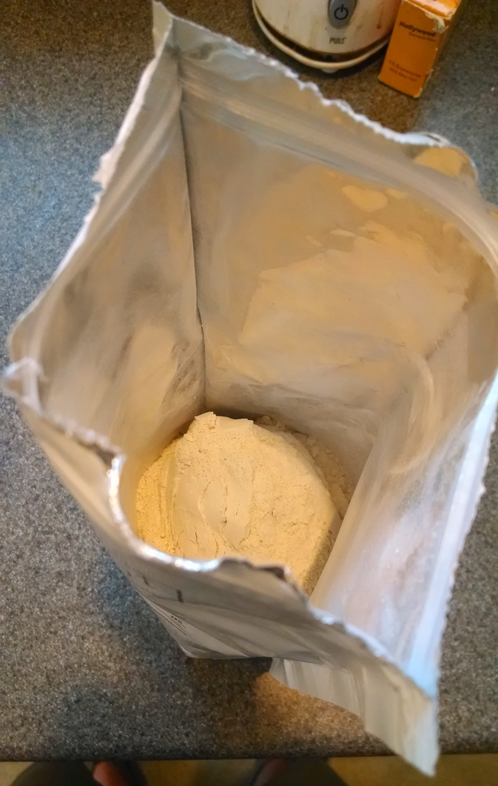
The Preparation
Once Soylent has been mixed with water, it has a recommended fridge lifetime of 48 hours. The instruction booklet suggests ways to make single servings if you aren't going to eat a full day's worth within that time. However, I'm going all in on this, so it's not a problem.
The pitcher that is included in the starter kit holds one day's worth of Soylent - one pouch and one vial of oil blend mixed into the proper amount of water. This means that it conveniently serves as a measuring device - just dump the powder and the oil in and then fill the rest up with water.
The instruction booklet recommends a slightly more nuanced procedure. First, dump the powder into the pitcher. Then fill most of the way up with water. Shake vigorously for 30 seconds. Then add the oil blend and fill the remaining space with water. Shake vigorously again for 30 seconds.
When I first added the water to the pitcher of powder, it looked as though the powder was somehow resistant to mixing with the water. However, probably due to the fine grain of the powder, after 30 seconds of vigorous shaking, the mixture was completely mixed. The whole thing was pretty heavy, and after adding the oil blend and shaking for another 30 seconds, my arms were pretty tired.
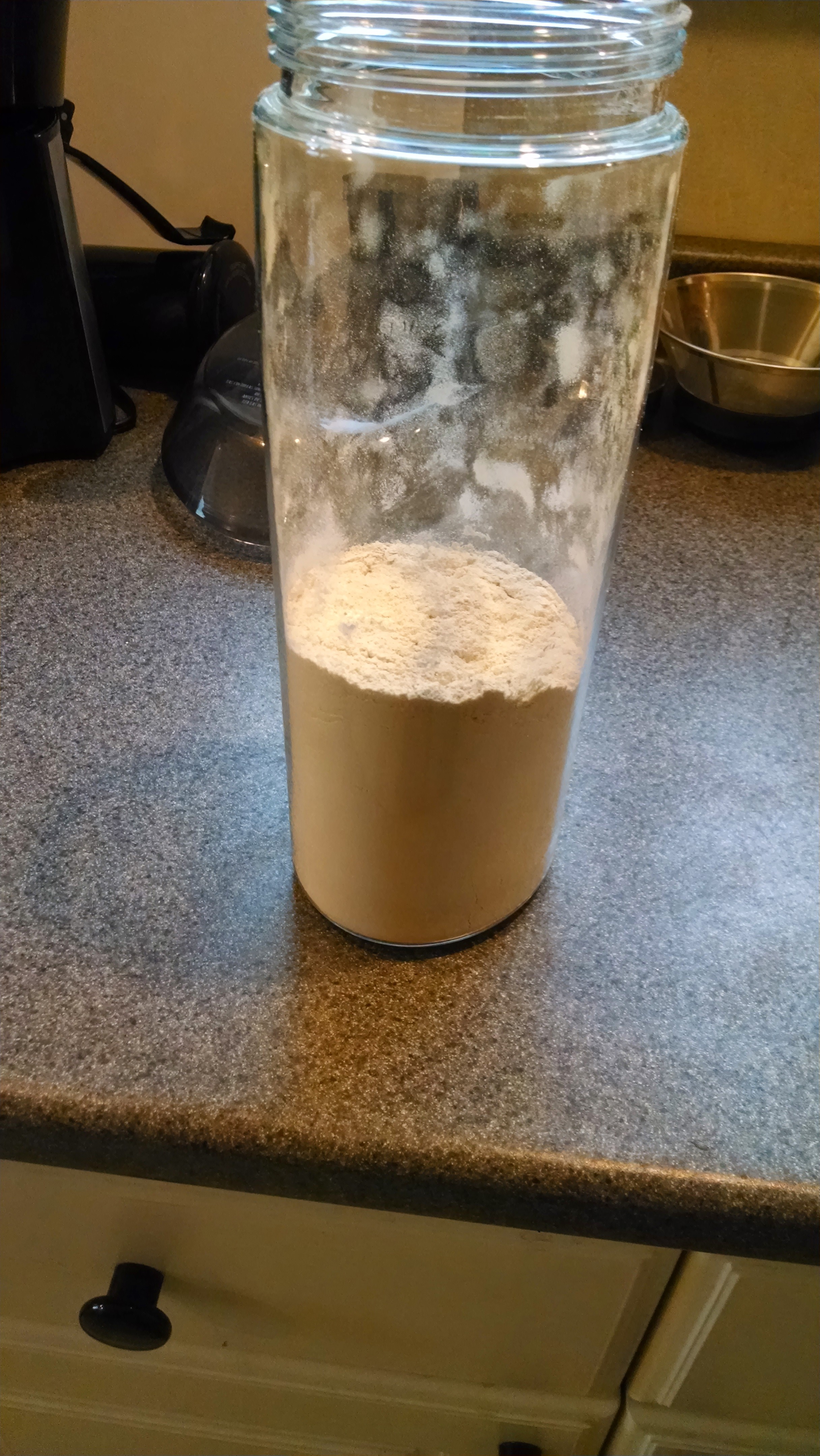
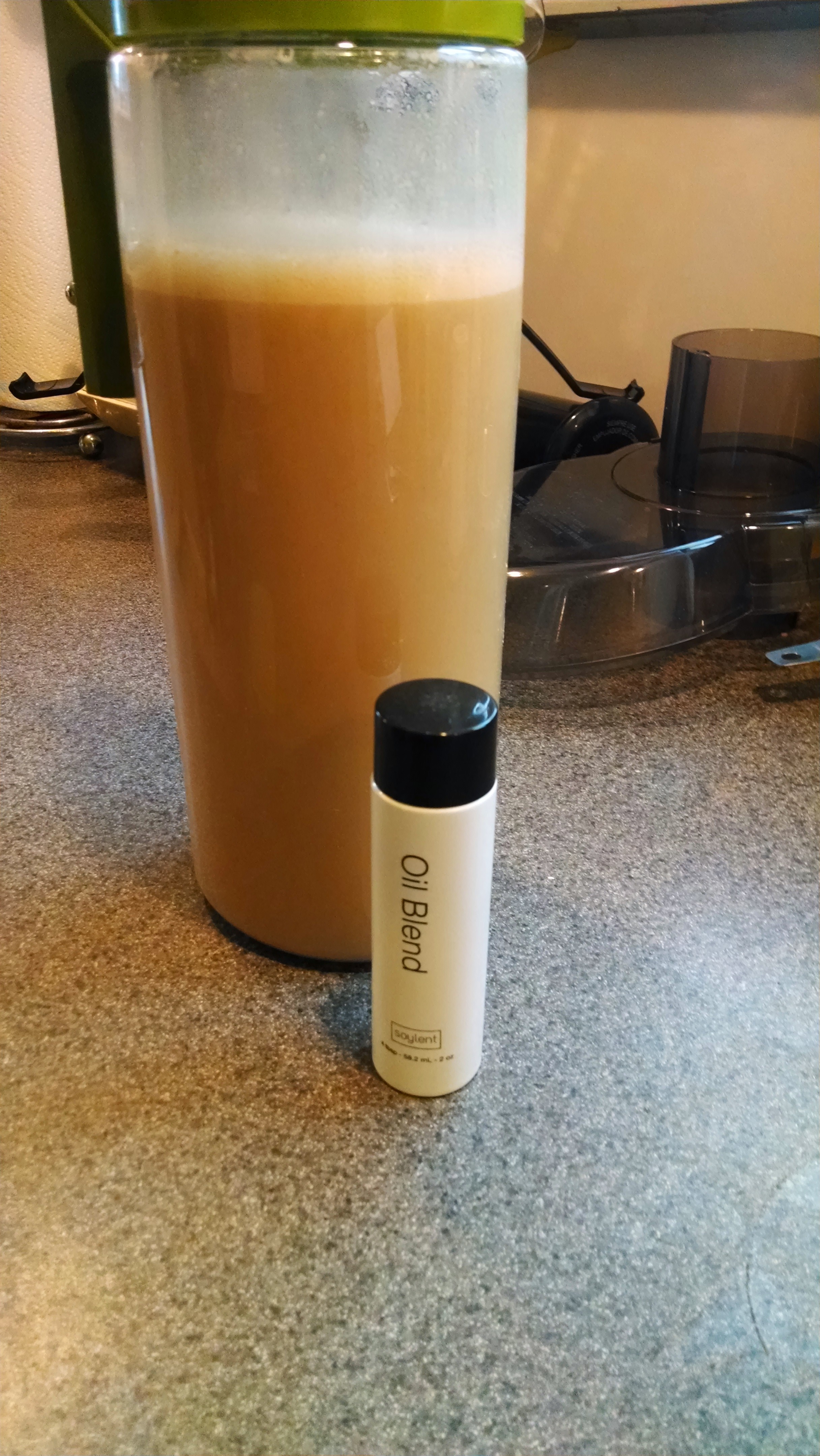
The Consumption
The resultant liquid has the same sickly sweet smell as the powder, and I was afraid that drinking it would be quite unpleasant. However, it didn't taste nearly as bad as it smelled. I'd heard reports that it had a grainy texture, but I didn't find that to be an accurate description. I could certainly tell that it had been mixed from a powder, but the powder was fine enough that I couldn't make out the individual grains. Instead, it had a smooth but heavy texture somewhat like a well-blended milkshake made from dense ice cream.
However, there was something off-putting about it. I couldn't place my finger on what it was, but I found that drinking it gave me a sensation like what I was drinking tasted actively bad, though it didn't actually taste that way. In order to make it more palatable, I blended in four frozen strawberries with a glass (about one serving, or one third of a full day's worth). This helped, but I still found it off-putting. When I drank water shortly after drinking the Soylent, I got a mild queasy feeling in my stomach.
I have a few hypotheses here. First, maybe it just takes some getting used to. Second, maybe I shouldn't have eaten it on a full stomach (remember those Twizzlers?). Or maybe it's something else. I'm going to look around online tonight and see what other people say about it. I'm sure there's no shortage of advice online about what to expect and how to make Soylent more palatable. I'll write about what I find in tomorrow's post.
Conclusion
That wraps up this first post. I expect that future posts will be much shorter. Please comment or write with questions, thoughts, or suggestions!
[1] Many users have reported having pretty bad gas while their digestive tracts adjust; it usually goes away pretty quickly (a few days to a week).
This is a post in the Soylent series.
Posts in this series:
- Soylent: In Review -
- Soylent: Day 17 -
- Soylent: Day 16 -
- Soylent: Day 15 -
- Soylent: Day 14 -
- Soylent: Day 13 -
- Soylent: Day 12 -
- Soylent: Day 11 -
- Soylent: Day 10 -
- Soylent: Day 9 -
- Soylent: Day 8 -
- Soylent: Day 7 -
- Soylent: Day 6 -
- Soylent: Day 5 -
- Soylent: Day 4 -
- Soylent: Day 3 -
- Soylent: Day 2 -
- Soylent: The Blog Series -